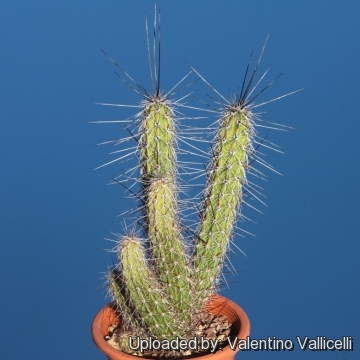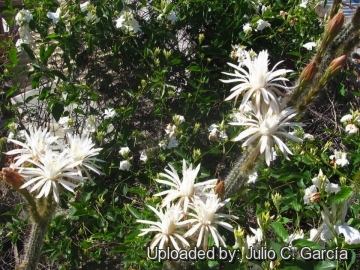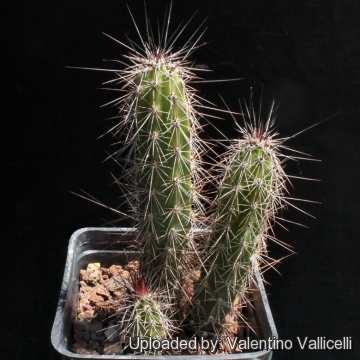
Peniocereus serpentinus Photo by: Julio C. García
Origin and Habitat: Tropical areas of southern Mexico (Guanajuato, Hidalgo, Jalisco, México, Michoacán, Morelos, Nayarit, Oaxaca, Puebla, Aguascalientes Querétaro and Sinoaloa), but now largely spreading around Mexico. It has also been naturalized in many regions, such as Australia and it is widely cultivated because of its flowers.
Habitat and Ecology: The species grows in tropical deciduous dry forest. There are no known major threats to this species.
Synonyms:
See all synonyms of Peniocereus serpentinus
Common Names include:
ENGLISH: Mexican Night-blooming Cereus, Serpent cactus, Snake Cactus
SPANISH (Español): Junco, Junco Espinoso, Pitahayita, Reina De La Noche
Description: Peniocereus serpentinusSN|7249]]SN|7249]] is a fast-growing slender, shrubby columnar cactus that grows often in groups, erect at first sometimes climbing then leaning and sprawling all over and best tied to something so it wont fall and grow decumbent. It would be good for hanging baskets. This species is in need of taxonomic review as in Mexico it is recognized as a separate genus Nyctocereus; there is genetic evidence for this.
Stem: Slender, snake-like, dark coloured, cylindrical, 3-6 meters long, 2,5-5 cm in diameter.
Roots: Large tuberose.
Ribs: 10-17 obtuse.
Areoles: Whitish white wool.
Spines: 9 to 14 needle-like spines, whitish to reddish when young, with darker tips, 10-30 mm long.
Flowers: When old enough it bears large, nocturnal flowers, they are funnelform, white with pinkish outside segments, 15 to 20 cm long (15 cm in diameter), pericarpel and flowers with bristles. The flowers are very fragrant, like gardenias.
Fruits: 4-6 cm long, red, egg-shaped, edible, spiny, with spines that fall when it is ripe.
Seeds: Black 5 mm Long.
Subspecies, varieties, forms and cultivars of plants belonging to the Peniocereus serpentinus group
 Peniocereus serpentinus (Lag. & Rodr.) N.P.Taylor: It is fast-growing slender, shrubby columnar cactus that grows often in groups, erect at first sometimes climbing then leaning and sprawling all over and best tied to something so it wont fall and grow decumbent.
Peniocereus serpentinus (Lag. & Rodr.) N.P.Taylor: It is fast-growing slender, shrubby columnar cactus that grows often in groups, erect at first sometimes climbing then leaning and sprawling all over and best tied to something so it wont fall and grow decumbent. Peniocereus serpentinus f. cristata: The crested form stay smaller and forms pronounced sculpture effects.
Peniocereus serpentinus f. cristata: The crested form stay smaller and forms pronounced sculpture effects.
Bibliography: Major references and further lectures
1) Edward F. Anderson “The Cactus Family” Timber Press, 2001
2) James Cullen, Sabina G. Knees, H. Suzanne Cubey “The European Garden Flora Flowering Plants: A Manual for the Identification of Plants Cultivated in Europe, Both Out-of-Doors and Under Glass” Cambridge University Press, 11/Aug./2011
3) David Hunt, Nigel Taylor “The New Cactus Lexicon” DH Books, 2006
4) Cullmann W., Götz E., Gröner G.”Kakteen: Kultur, Vermehrung und Pflege - Lexikon der Gattungen und Arten” Ulmer, Stuttgart, 1984
6) Hans Hecht “BLV-Handbuch der Kakteen” BLV-Verlagsgesellschaft, 1982
8) Arreola, H., Bárcenas Luna, R., Cházaro, M., Guadalupe Martínez, J., Sánchez , E. & Terrazas, T. 2013. Peniocereus serpentinus. The IUCN Red List of Threatened Species. Version 2014.3. <www.iucnredlist.org>. Downloaded on 25 November 2014.
 Peniocereus serpentinus Photo by: Valentino Vallicelli
Peniocereus serpentinus Photo by: Valentino Vallicelli Peniocereus serpentinus Photo by: Julio C. García
Peniocereus serpentinus Photo by: Julio C. García Peniocereus serpentinus Photo by: Valentino Vallicelli
Peniocereus serpentinus Photo by: Valentino Vallicelli Peniocereus serpentinus Photo by: Valentino Vallicelli
Peniocereus serpentinus Photo by: Valentino Vallicelli Peniocereus serpentinus Photo by: Valentino Vallicelli
Peniocereus serpentinus Photo by: Valentino VallicelliSend a photo of this plant.The gallery now contains thousands of pictures, however it is possible to do even more. We are, of course, seeking photos of species not yet shown in the gallery but not only that, we are also looking for better pictures than those already present.
Read More... Cultivation and Propagation: Produces best results in loose and very drained soil, rich in leaf-mould, and if sufficient water is supplied in warm weather a rather considerable growth can be made. It needs bright shade to partial sun. The plants will stand but little cold and require a minimum winter temperature of about 10° C. (but can resist for short period to 0° C). Growth is rapid, and supports are needed for the stems. The half‑erect habit of the moderately tall plants makes them desirable for middle foreground position in landscaping, while the comparatively small room needed for potted plants makes it an acceptable group for greenhouse culture.
Garden uses: In Mexico it is one of the most widely cultivated species for the beauty of its white flowers that open at night. Sometime it is used as a strong and fast growing grafting stock.
Food uses: It is grown in Mexico (Sonora), California and Chile for its fruit.
Propagation: By cuttings.
















